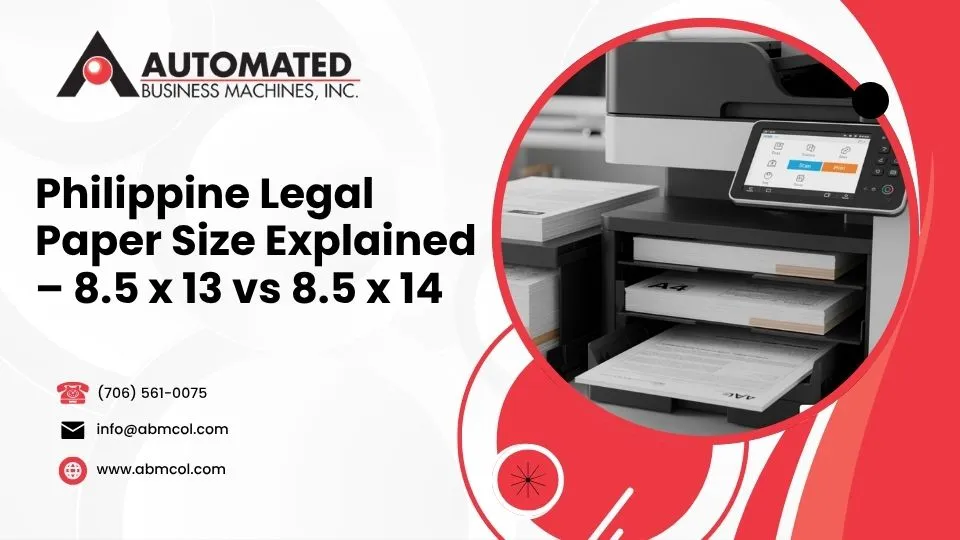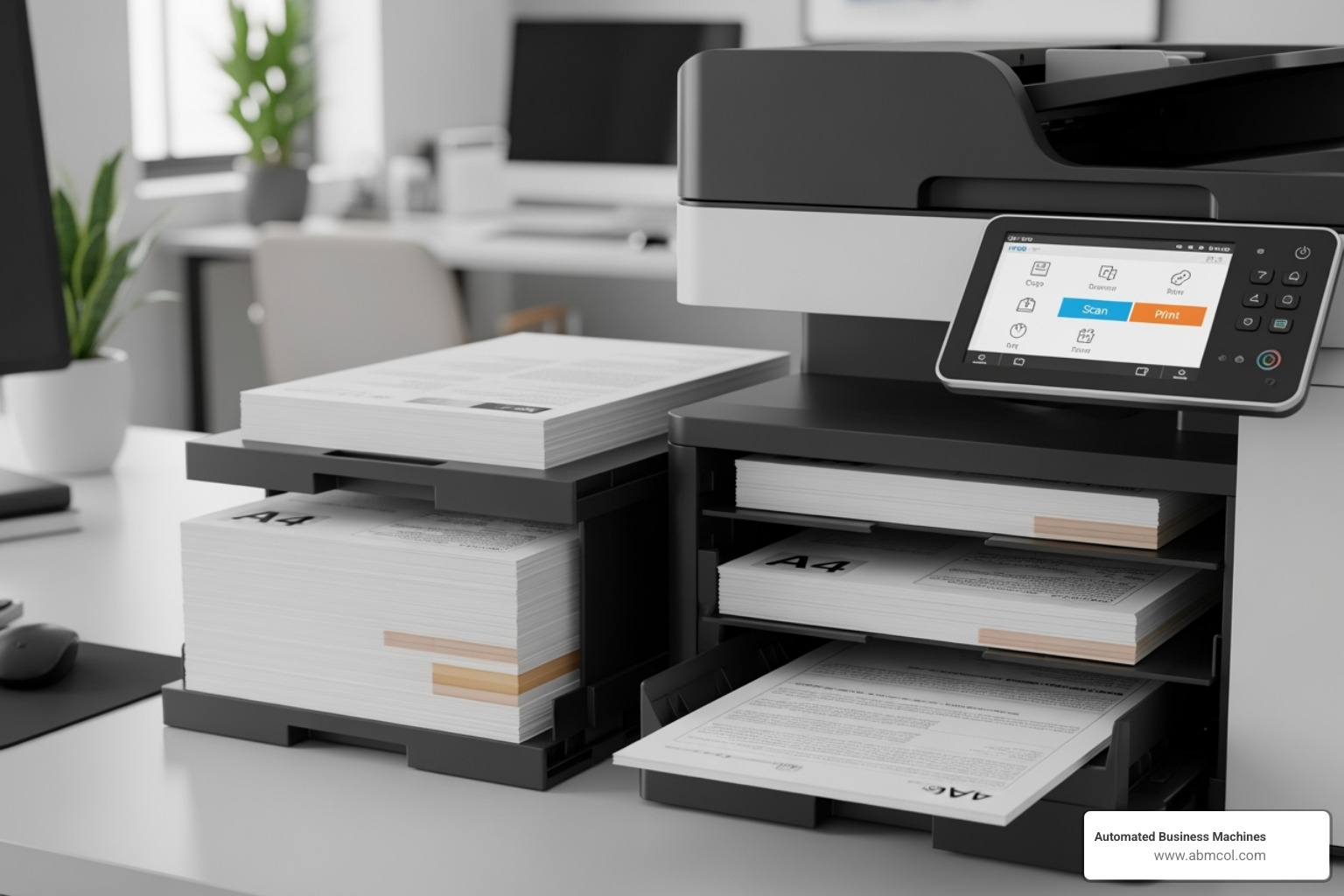
AI Overview:
Philippine legal paper uses a unique 8.5 x 13 inch size—one inch shorter than the U.S. Legal format. This guide explains the exact dimensions, why the Philippines uses this standard, how it compares to Letter, Legal, and A4, and how Georgia businesses can set up documents to print correctly. With quick references and simple printing steps, it helps prevent cut-off text, formatting issues, and costly reprints when working with Filipino partners.
Understanding the Philippine Paper Size Standard
For businesses in Georgia and across the US that work with international partners, understanding different paper standards is crucial for smooth operations. A common point of confusion arises with documents from the Philippines, which uses a unique legal size paper dimensions philippines of 8.5 x 13 inches. This format, often called “long bond paper,” differs from the standard US Legal size of 8.5 x 14 inches.
Quick Reference for Common Paper Sizes:
- Long Bond Paper (Philippine Legal): 8.5 x 13 inches (216 x 330 mm)
- US Legal Size: 8.5 x 14 inches (216 x 356 mm)
- Short Bond Paper (Letter): 8.5 x 11 inches (216 x 279 mm)
- A4 International Standard: 8.27 x 11.69 inches (210 x 297 mm)
If your business has ever dealt with documents from the Philippines, you’ve likely encountered the confusion around “long bond paper.” Many people assume it’s the same as US Legal size, but it’s actually one inch shorter. This creates real problems when printing documents formatted for the standard US Legal size.
The mix-up happens so often that Reddit users have shared PSAs about it: “Our ‘long’ bond paper is called ‘US Legal’ but it measures 8.5 × 13 inches. The real US legal is 8.5 × 14 inches.”
This confusion can lead to printing errors, document cutoffs, and frustrated office managers trying to figure out why their international legal documents don’t fit properly on the page.
Understanding the Official Legal Size Paper Dimensions Philippines
If you’ve ever been confused about international paper sizes, you’re definitely not alone. What is called “legal size paper” in the Philippines is actually quite different from the US standard. Let’s clear up this puzzle once and for all.
What are the Exact Legal Size Paper Dimensions Philippines?
Here’s the key fact: legal size paper dimensions philippines measure exactly 8.5 x 13 inches. This is the standard, but it creates a lot of confusion when interacting with international documents.
This size is locally known as “long bond paper,” though you might also see it referred to as “Folio size” in technical settings. Whatever the name, the measurements stay the same.
Let’s break down these dimensions so you can work with them in any format:
In inches: 8.5 x 13 inches
In centimeters: 21.59 x 33.02 cm
In millimeters: 215.9 x 330.2 mm
Working with digital files? You’ll need the pixel dimensions too. At 300 DPI (which is standard for quality printing), Philippine legal size paper measures 2550 x 3900 pixels. Getting this right prevents those annoying pixelated printouts that make your documents look unprofessional.
If you need more detailed conversions, our Legal Size Paper Dimensions in MM: Essential Guide covers everything in metric measurements. For digital designers, the Legal Size Paper Dimensions in Pixels Guide is incredibly helpful.
Understanding these exact measurements saves you from printing disasters and ensures your documents look exactly as you intended.
The Confusion: Philippine Long Bond vs. US Legal Size
Here’s where things get tricky for US businesses. While the Philippines uses 8.5 x 13 inches for its “long bond paper,” actual US Legal size is 8.5 x 14 inches. That one missing inch causes real problems.
Picture this: Your Atlanta office formats an important contract for standard US Legal size, sends it to a partner in the Philippines who prints it on long bond paper, and suddenly the bottom of your document is cut off. The signature line? Gone. The contact information? Missing. It happens more often than you’d think.
The mix-up stems from a historical connection to US paper standards. For decades, US Letter and US Legal sizes were common there. But somewhere along the way, the 8.5 x 13 inch dimension became the local standard while keeping the “legal” name. It stuck, even though it’s technically different.
This isn’t just a minor inconvenience. One Reddit user shared how a document printed on A4 paper had to be corrected and re-notarized for a Supreme Court submission in the Philippines because it didn’t meet the required local legal size—a clear example of how seriously these standards are taken. For a US business, such a mistake could lead to significant delays and compliance issues.
The lesson? Always confirm paper size requirements and specify Philippine legal size when you mean 8.5 x 13 inches. For a deeper dive into how legal paper compares to other sizes, check out our guide on Legal Size Paper vs. Letter Size: Key Differences.
Short Bond Paper and A4: Other Common Sizes
Beyond long bond paper, two other sizes are common in the Philippines and in international business: short bond paper and A4. Knowing all three helps you choose the right paper for any job.
Short bond paper is the same as US Letter size at 8.5 x 11 inches (216 x 279 mm). It’s the standard for everyday printing, from office memos in Columbus, GA, to school assignments.
A4 paper measures 8.27 x 11.69 inches (210 x 297 mm) and represents the international standard (ISO). While the Philippines officially adopted ISO standards, US-influenced sizes remain popular. Many modern offices prefer A4 for international correspondence and documents meant for global audiences. For complete A4 details, see our guides on Understanding A4 Paper Size and A4 Paper Size Dimensions in CM.
Here’s a quick comparison to help you visualize the differences:
| Paper Size | Dimensions (Inches) | Dimensions (mm) | Common Name |
|---|---|---|---|
| Philippine Long Bond | 8.5 x 13 | 216 x 330 | Long Bond / Folio |
| US Legal | 8.5 x 14 | 216 x 356 | Legal |
| US Letter | 8.5 x 11 | 216 x 279 | Letter / Short Bond |
| A4 | 8.27 x 11.69 | 210 x 297 | A4 |
What’s interesting is how the Philippine long bond paper sits right in the middle. It gives you more space than A4 or Letter size without the full length of US Legal. This can be a practical choice for many documents that need extra room but don’t require the full fourteen inches.
Common Uses and History in the Philippines
The 8.5 x 13 inch paper size isn’t just a quirky local measurement—it’s woven into the fabric of professional life in the Philippines. For any US business with Filipino partners, understanding its use is key to effective communication.
Everyday Applications of 8.5 x 13 Paper
If your business in Atlanta or Savannah deals with legal or government documents from the Philippines, you’ll find they are often printed on 8.5 x 13 inch paper. This slightly elongated format provides just the right amount of space for documents that need more room than standard letter size but don’t require the full bulk of US Legal paper.
Legal documents represent the most prominent use of long bond paper. Contracts, affidavits, deeds, and court pleadings all benefit from that extra two inches of length. The additional space allows lawyers to include detailed clauses, multiple signatures, and notarial seals without cramming everything together.
Government forms across various agencies in the Philippines have been designed specifically for this paper size. When dealing with tax documents, permits, or official applications from there, expect to encounter this format.
Academic papers and university documents also rely heavily on this format. The additional length reduces awkward page breaks and creates a more polished final product.
Business contracts and internal company documents frequently use long bond paper to accommodate detailed terms and conditions. The format strikes a perfect balance—providing enough space for comprehensive agreements without appearing unnecessarily bulky.
Certificates and official records like birth certificates and academic transcripts typically conform to this size. This consistency creates a recognizable, official appearance.
The practical balance of long bond paper is its key strength. It offers more content space than A4 or letter size, making documents more readable while avoiding the excessive length of full US Legal paper. For comprehensive information about these applications, check out our guide on Legal Size Paper Uses and Benefits.
A Brief History of Paper Standards in the Philippines
The story behind Philippine paper sizes is one of cultural adaptation and practical compromise. For decades, American influence shaped their paper standards, with US Letter (8.5 x 11 inches) and US Legal (8.5 x 14 inches) being common.
However, the 8.5 x 13 inch format quietly carved out its own territory. This dimension, sometimes called ‘Oficio’ in other countries, became a practical middle ground. While the exact origin is unclear, it clearly filled a real need in Filipino document culture.
The government attempted a major shift in 1986 through Joint Memorandum Circular No. 1, s. 1986, which mandated A4 size (210 mm x 297 mm) for all government communications. The goal was to align with international standards.
But changing deeply rooted habits proved difficult. While some government agencies adopted A4, the legal size paper dimensions philippines stubbornly persisted in law offices, private companies, and educational institutions. The Supreme Court and other judicial bodies continued requiring specific documents on 8.5 x 13 inch paper, creating a practical necessity that kept this format alive.
This historical tug-of-war explains why businesses today must be aware of multiple paper standards when dealing with Filipino entities. It’s not confusion on their part—it’s adaptation to a complex reality. Understanding this context helps US companies anticipate document requirements and avoid potential compliance issues.
How to Print on Philippine Legal Size Paper
Getting your printer to cooperate with the unique legal size paper dimensions philippines doesn’t have to be a battle. For any US office that needs to print or scan documents in this format, here are the exact steps to make your printer and software work together seamlessly with 8.5 x 13 inch paper.
Setting Up 8.5 x 13 in Microsoft Word & Google Docs
The secret to perfect printing starts with proper document setup. Most software doesn’t recognize “Philippine Long Bond” as a standard option, but both Microsoft Word and Google Docs make it easy to create custom paper sizes.
To set up Microsoft Word, open your document and go to the “Layout” tab (or “Page Layout” in older versions). In the “Page Setup” group, click “Size” and then select “More Paper Sizes…” at the bottom.
This opens the “Page Setup” dialog box. On the “Paper” tab, under “Paper size,” select “Custom size” from the dropdown menu. Now you can manually enter the dimensions: Width: 8.5″ and Height: 13″. Click “OK” and your document is now properly formatted.
Google Docs makes things even easier. Open your document and go to “File” > “Page setup.” In the “Paper size” dropdown menu, look for “Folio (8.5″ x 13″)”. If you find it, select it and click “OK“—you’re done!
This simple setup step saves you from the frustration of finding formatting problems only after you’ve already printed dozens of pages.
Key Printing Considerations for Legal Size Paper Dimensions Philippines
Setting up your document correctly is only half the story. Your printer needs to be on board too. The most common mistake is assuming that if your document looks right on screen, it’ll print perfectly.
Your printer settings must match your document settings. Before clicking print, always check your printer preferences. Look for the “Paper Size” or “Media Size” option. If 8.5 x 13 inches isn’t listed, select “Custom” and manually input the dimensions. Some printer drivers include a “Folio” option, which is exactly what you want.
Paper tray compatibility is another crucial factor. Check your printer’s specifications to make sure it can accommodate the 13-inch length. Many printers have adjustable paper trays or a bypass tray for non-standard sizes. Ensure the paper guides are snug against the paper to prevent crooked feeding.
The dreaded cutoff text problem usually happens when someone formats a document for 8.5 x 14 inch US Legal but prints it on 8.5 x 13 inch paper. Always use print preview before committing to a full print run—it’ll show you exactly what will fit on the page.
PDF printing requires special attention. When printing PDFs, you’ll see options like “Fit,” “Actual Size,” or “Shrink Oversized Pages.” If your PDF was designed for 8.5 x 13, stick with “Actual Size.” If it was created for the longer 8.5 x 14 format, you might need “Shrink Oversized Pages” to make everything fit.
At Automated Business Machines, we see these printing challenges every day. Our experience helping businesses across Georgia, from Columbus to Augusta, shows that proper setup from the start prevents most printing headaches. Our multifunction printing solutions are designed to handle these custom workflows, keeping your operations running smoothly. For more detailed guidance, check out our comprehensive guide on Legal Document Printing.
Frequently Asked Questions about Philippine Paper Sizes
Navigating international paper sizes can feel like solving a puzzle. Here are answers to the most common questions about these paper standards.
Is 8.5 x 13 the same as F4 paper?
This question comes up constantly, and the answer is: mostly yes, but with a small technical difference.
F4 paper or Folio is a term used in many parts of the world, particularly Southeast Asia, for paper that is very close to 8.5 x 13 inches. The official ISO standard for F4 is 210 mm x 330 mm (about 8.27 x 12.99 inches). The Philippine long bond paper is slightly wider at 8.5 x 13 inches (215.9 x 330.2 mm).
For most practical purposes, the dimension differences are negligible. Printers can typically handle both without issue, and they are often used interchangeably. The key takeaway is that if an international partner requests F4 or Folio, they are likely referring to this 13-inch-long format.
Why does the Philippines use 8.5 x 13 instead of the standard US Legal or A4?
The story behind the unique legal size paper dimensions philippines is a mix of history and practicality.
The historical influence from the American colonial period brought US paper standards to the Philippines, including the 8.5 x 11 inch Letter and 8.5 x 14 inch Legal sizes. However, the 8.5 x 13 inch size emerged as a local convention that offered a practical compromise.
From a practicality standpoint, standard letter-sized paper can feel cramped for detailed legal or government documents. But the full 14-inch US Legal size can be awkwardly long to handle and file. The 8.5 x 13 inch "long bond" hits a sweet spot, providing extra room without the bulk.
Once local institutions designed their processes around this size, it became deeply embedded. Even when the government tried to shift to the A4 international standard, the 8.5 x 13 inch format was too established in daily commerce and legal practice to disappear.
Where can I buy 8.5 x 13 long bond paper?
While readily available in the Philippines, finding 8.5 x 13 inch paper in the US requires a bit more searching. It's often sold online under the name "Folio" or by its exact dimensions.
Major office supply retailers like Staples or Office Depot often carry this size on their websites, though it may not be stocked in physical stores. Be sure to search for "8.5 x 13 paper" or "Folio paper."
Online marketplaces like Amazon are another reliable source, with multiple sellers offering reams of 8.5 x 13 inch paper.
For businesses in Georgia that need a consistent supply, Automated Business Machines can help. As part of our managed print services, we can assist in sourcing specialty paper sizes to ensure your office is always equipped for international document handling. For budget-conscious buyers looking to stock up, our guide on Affordable Legal Size Paper Options offers some helpful money-saving tips.
Conclusion: Choosing the Right Paper for Your Needs
For companies across Georgia—from law firms in Atlanta to logistics hubs in Savannah—mastering the nuances of international paper standards is a practical business advantage. Understanding that the legal size paper dimensions philippines use a unique 8.5 x 13 inch format can prevent costly reprints, shipping delays, and compliance issues when dealing with Filipino partners.
Your workflow becomes smoother when you master these basics. Setting up a custom 8.5 x 13 inch size in your software and configuring your printer settings correctly ensures your documents look professional and are accepted without issue.
At Automated Business Machines, we specialize in helping Georgia businesses streamline these very processes. Our multifunction printing solutions are designed to handle diverse paper sizes and complex document workflows, ensuring your operations run efficiently, whether you’re printing a local memo or an international contract.
The investment you’ve made in learning about these paper standards pays dividends every time you print. Your documents look professional, your processes run efficiently, and you avoid the headaches that come from paper size mix-ups.
As your locally owned and operated partner serving communities from Macon to Marietta, we’re here to provide ongoing support for all your printing and document management needs. Explore more resources at Legal Size Paper and our comprehensive guide at https://www.abmcol.com/legal-paper-size-paper-dimensions/.
Every professional document starts with choosing the right foundation. Now you have the knowledge to build on solid ground.




